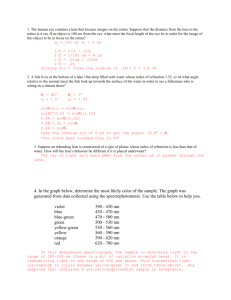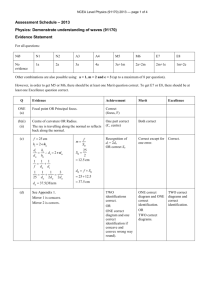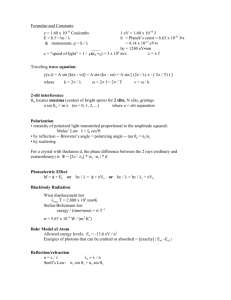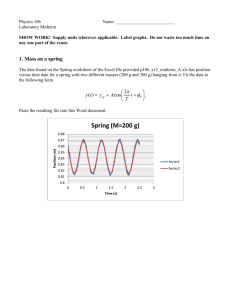Solution Derivations for Capa #13
advertisement
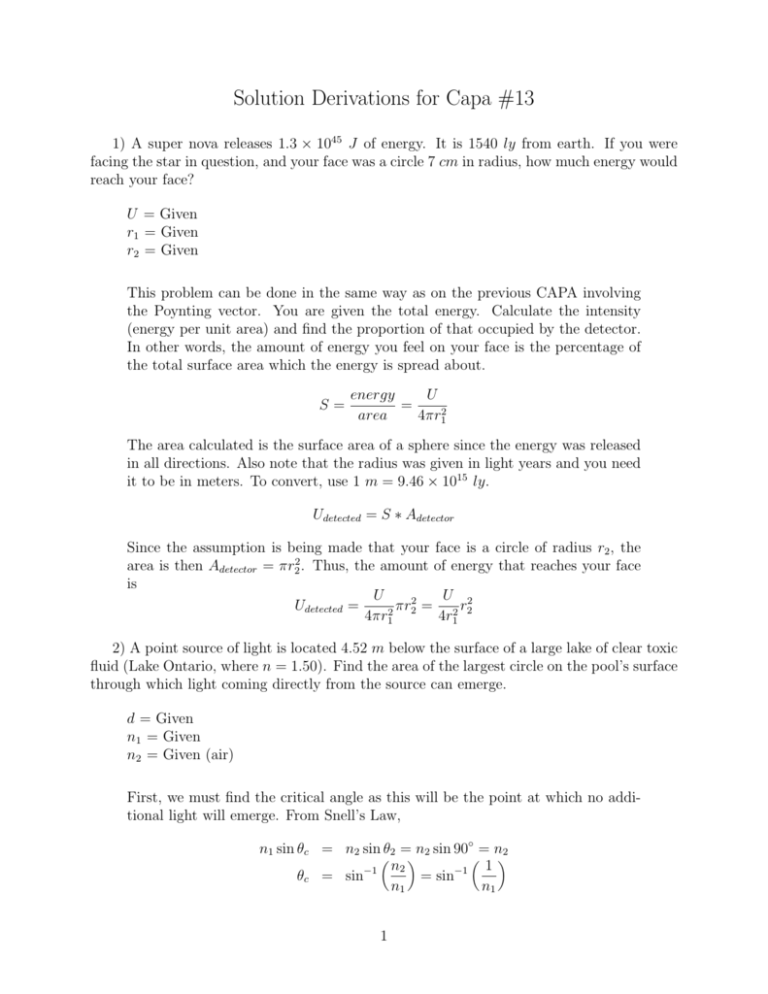
Solution Derivations for Capa #13 1) A super nova releases 1.3 × 1045 J of energy. It is 1540 ly from earth. If you were facing the star in question, and your face was a circle 7 cm in radius, how much energy would reach your face? U = Given r1 = Given r2 = Given This problem can be done in the same way as on the previous CAPA involving the Poynting vector. You are given the total energy. Calculate the intensity (energy per unit area) and find the proportion of that occupied by the detector. In other words, the amount of energy you feel on your face is the percentage of the total surface area which the energy is spread about. S= energy U = area 4πr12 The area calculated is the surface area of a sphere since the energy was released in all directions. Also note that the radius was given in light years and you need it to be in meters. To convert, use 1 m = 9.46 × 1015 ly. Udetected = S ∗ Adetector Since the assumption is being made that your face is a circle of radius r2 , the area is then Adetector = πr22 . Thus, the amount of energy that reaches your face is U U πr22 = 2 r22 Udetected = 2 4πr1 4r1 2) A point source of light is located 4.52 m below the surface of a large lake of clear toxic fluid (Lake Ontario, where n = 1.50). Find the area of the largest circle on the pool’s surface through which light coming directly from the source can emerge. d = Given n1 = Given n2 = Given (air) First, we must find the critical angle as this will be the point at which no additional light will emerge. From Snell’s Law, n1 sin θc = n2 sin θ2 = n2 sin 90◦ = n2 1 −1 n2 −1 θc = sin = sin n1 n1 1 Where the last step follows since the ray is emerging into air. Now, we can find the length of the triangle which will be the radius of the largest circle of which light can still emerge. Thus, φ = 90◦ − θc d tan φ = r d d r = = tan φ tan (90◦ − θc ) The area of a circle is d A = πr = π tan (90◦ − θc ) !2 2 3) A laser beam enters a 14.0 cm thick glass window at an angle of 46◦ (from the normal). The index of refraction of the glass is 1.50. At what angle from the normal does the beam travel through the glass? Use units of “deg.” w = Given (width) θ1 = Given n2 = Given n1 = Given (air) Thus, using Snell’s Law, n1 sin θ1 = n2 sin θ2 −1 n1 θ2 = sin sin θ1 n2 1 −1 sin θ1 = sin n2 2 4) How long does it take the beam to pass through the plate? This one is a bit trickier since the ray does not travel straight through the glass. The index of refraction for a material comes from the ratio of speed that light travels through it. That is, c n= v Thus, the speed is c v= n Since velocity is distance over time, t= d d dn = c = v c n Since θ2 was calculated in the previous problem, the distance is calculated by cos θ2 = d = w d w cos θ2 Thus, the time required for the light to travel through the glass is t= dn w∗n = c c ∗ cos θ2 5) Light in air enters a stack of three parallel plates with indices of refraction 1.38, 1.52, and 1.98, respectively. The incident beam makes a 74.0◦ angle with the normal to the plate surface. At what angle with respect to the stack normal does the beam emerge into the air after passing through the stack? Use units of “deg.” (If you do a lot of calculations for this one, you will kick yourself when you realize the answer.) 3 n1 = Given n2 = Given n3 = Given θ1 = Given When light travels through different media but emerges back into the original medium, it will be traveling in the same direction; thus the angle at which it emerges will be the same as that when it entered. Thus, θf = θ1 6) A woman stands between a vertical mirror 0.40 m tall and a distant tree whose height is H. She is 2.30 m from the mirror, and the tree is 17.0 m from the mirror. If she sees the tree just fill the mirror, how tall is the tree? d = Given h0 = Given (image height) l0 = Given (image distance) From the magnification equation, we can find the height of the tree, h. h0 l0 = h l l ∗ h0 h = l0 Note that since the image fills the mirror, the image height is the size of the mirror. Also, the distance to the object is the distance from the object to the mirror plus the distance back to the observers eye. Thus, l = d + l0 4 So, (d + l0 ) ∗ h0 h= l0 7) A student uses a semicircular flat plastic box to observe the optical properties of liquids. As shown in the figure, she sets two pins to observe through the water. When the box is filled with water (index of refraction = 1.33) she observes the images of the pins defining the paths X and Y and measures the angles α and β. They are α = 49.7◦ , and β = 35.0◦ . Replacing the water with another liquid (index of refraction = 1.48), she remeasures the values for angles α and β. What is the value of α in the presence of the new liquid? Use units of “deg.” n = Given (original liquid) n1 = Given (new liquid) θ1 = Given α = Given β = Given All you need to know for this problem are n1 and θ1 . Snell’s Law tells us n1 sin θ1 = n2 sin θ2 Since the light ray is travelling from the liquid into the air, n1 is the refractive index of the liquid and n2 is that of air; namely 1. The outgoing angle is labeled α in the diagram. Substituting this back in, n1 sin θ1 = n2 sin α = sin α Thus, α = sin−1 (n1 sin θ1 ) 8) A light ray strikes the surface between two transparent materials as shown. Each angle is labeled with a letter. Give the letters for the angle of incidence, angle of refraction and angle of reflection, in that order (e.g. dbb.) Note the direction of the rays. The ray approaching the boundary is the incident ray. The angle of incidence is measured between this ray and the normal line to the boundary. The reflected ray travels away from the boundary, but on the same side as the incident ray. The angle of reflection is the angle between this ray and the normal line. The refracted ray also travels away from the boundary, but it is inside the other medium at the boundary. 9) A beam of light, colored as indicated, strikes one face of a glass prism at various angles, as shown in each choice above. Which choices correctly represent the passage of the light through the prism? Note carefully whether the beams within the prism are parallel. (Enter all correct choices in alphabetical order, e.g., B, CD, or ABE). 5 A) Incorrect since the rays are refracted by different amounts within the medium. B) Correct. C) Incorrect since red light is refracted less than violet light; thus it would be on top. D) Incorrect. Not sure why this is incorrect. E) Incorrect since the light is refracted at every boundary where it is incident with a nonzero angle (it would have been refracted while exiting the prism). CAPA is only looking for the correct answers. In this case, B. 10) In the above figures f is located at the focal point of the lens. For each statement enter T or F. QUESTION: A) An object placed between f and the lens in Fig. a results in an image on the right side of the lens. B) The lens in Fig. b is a converging lens. C) An object placed to the left of f and the lens in Fig. a produces a virtual image. D) An object placed to the left of f in Fig. b results in an image on the right side of the lens. E) An object placed to the left of f and the lens in Fig. b produces a virtual image. F) An object placed to the left of f in Fig. a results in an image on the right side of the lens. G) An object placed between f and the lens in Fig. a produces a real image. ANSWER: Playing with the JAVA lens applet will help answer these questions. A) False, an object placed here will produce a virtual image. Not enough “bending power” to make a real image. Consequently, the virtual image is formed, upright, on the left side of the lens (with the object). B) False, a lens with this shape is a diverging lens. Rays will bend toward the thicker part of a lens, thus causing them to diverge from a point in this image. 6 C) False, this position will produce a real image. D) False, a diverging lens cannot produce a real image. E) True, see (D) F) True, if the image is further away than one focal length, a real image is formed, inverted, on the opposite side of the lens. G) False, see (A) CAPA is looking for true/false answers to these questions. Thus, for this problem, FFFFTTF 11) Starting with a real object, which of the following statements are TRUE about the image formed by a single lens? (Enter all correct choices in alphabetical order, e.g. B, CD, or ABE). QUESTION: A) A diverging lens always produces a virtual, upright, reduced image. B) A converging lens can never produce a virtual, upright, reduced image. C) A converging lens cannot produce a real, inverted reduced image. D) For a converging lens an object has to be placed between the focal length and the lens in order to form a virtual image. E) A converging lens can produce a virtual, upright, enlarged image. F) A diverging lens can produce a real, inverted, reduced image. ANSWER: Playing with the JAVA lens applet will help answer these questions. A) True. B) True, the virtual, upright images it forms are always magnified. C) False, an object placed further than 2f away from the lens will be a real, inverted, and reduced image. D) True, see (10A). E) True, this is the only type of virtual image it can produce. F) False, a diverging lens cannot produce a real image. CAPA is looking for the letters of the correct answers, in this case, ABDE 12) How much is the light ray displaced after passing through the 5.30 cm thick sheet of transparent material (n = 1.33) with an incident angle of θ = 34.0◦ . d = Given n1 = Given (Air) n2 = Given θ1 = Given 7 Starting with Snell’s Law, n1 sin θ1 = n2 sin θ2 Thus, n1 1 θ2 = sin sin θ1 = sin−1 sin θ1 n2 n2 The hypotenuse, h, of this first triangle can be found by −1 cos θ2 = h = d h d cos θ2 The angle between the refracted ray and the original ray is then α = θ1 − θ2 Looking at the second triangle, we can see that x h x = h sin α sin α = 8



